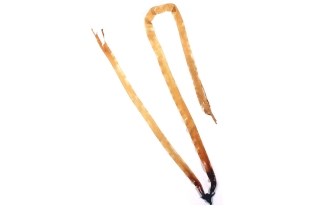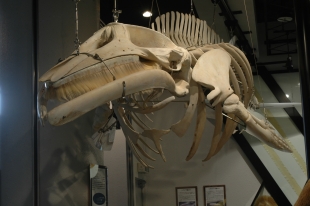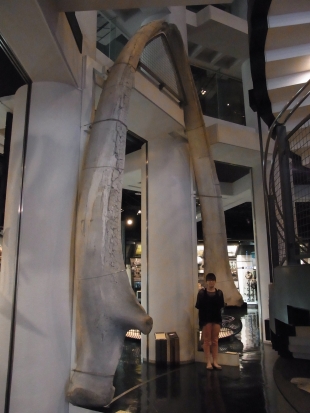1-28~30 Sea of Kushiro 2
1-28 Kelp: A Valuable Food Source
Along the rocky shore on the east side of Kushiro Bay, cold currents create ideal conditions for the growth of kelp. Many types of kelp are valued in Japanese cuisine for adding depth of flavor to soups and stocks, and rich kelp beds can be found along much of the east coast of Hokkaido. Some species, including naga-konbu (Saccharina longissima), gaggara-konbu (Saccharina coriacea), gohei-konbu (Laminaria yezoensis), and nekoashi-konbu (Arthrothamnus bifidus) are only found around Kushiro and Hokkaido’s east coast. The most common species in the area is naga-konbu, also called ribbon weed, which can grow as long as 10 meters.
In addition to its value as a food source, kelp protects smaller fish from buffeting waves and provides shelter from larger predators along the rocky coast of Kushiro Bay. Fish also feed on species that live in kelp beds, such as mysid shrimp and plankton.

1-29 Minke Whales
he minke whale (Balaenoptera acutorostrata), like the blue whale, is a species of baleen whale. It generally feeds on krill, small squid, and fish. It filters its food through bristle-like baleen plates, made of keratin. The Japanese name for the minke whale is higekujira, which means bearded whale.
From land to sea
Minke whales are cetaceans (a group which includes whales, dolphins, and porpoises), marine mammals that transitioned from land to sea many millions of years ago. The minke whale is a living example of that evolution. The small bones that remain near the whale’s spine in the rear of its body are all that remains of its legs after millions of years of evolution.
Minke whales migrate to the seas around Kushiro every autumn. Since commercial whaling recommenced in 2019, a small number are harvested off the coast of Kushiro under strict catch quotas.

1-30 Blue Whales
The blue whale (Balaenoptera musculus) is one of the largest animals that has ever lived. Blue whales can grow up to 32 meters long and weigh up to 200 tons. Like minke whales, they use brush-like baleen plates made of keratin to filter several tons of krill into their mouths every day. The lower jawbone on exhibit at the Kushiro City Museum is 6.7 meters long. The whale it belonged to would have been around 25 meters long.
This jawbone came from a whaling expedition conducted more than 50 years ago (the blue whale has been protected from commercial whaling since 1966). In the past, whales were hunted by companies based in Kushiro and other locations along Hokkaido’s east coast. Small-scale commercial whaling recommenced in the area in 2019, but the blue whale remains a protected species.

This English-language text was created by the Japan Tourism Agency.
このページに関するお問い合わせ
生涯学習部 博物館 博物館担当
〒085-0822 北海道釧路市春湖台1番7号 博物館
電話:0154-41-5809 ファクス:0154-42-6000
お問い合わせは専用フォームをご利用ください。
